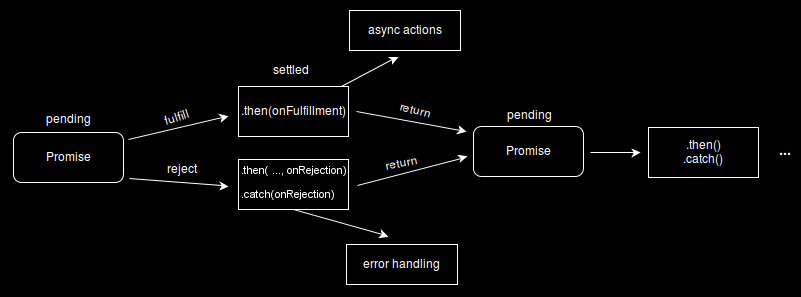Promise
The Promise object represents the eventual completion (or failure) of an asynchronous operation and its resulting value.
It is a proxy for a value not necessarily known when the promise is created. It allows you to associate handlers with an asynchronous action’s eventual success value or failure reason.
This lets asyn methods return values like synchronous methods: instead of immediately returning the final value, the asynchronous method returns a promise to supply the value at some point in the future.
A promise can be in one of the following 3 states:
- pending: initial state, neither fulfilled nor rejected
- fulfilled: meaning that the operation was completed successfully
- rejected: meaning that the operation failed
When either of these options occur, the associated handlers queued up by a promise’s then method are called.
The then method also returns a promise, so they can be chained together to do anything. Look at the diagram below:

Chaining Promises
The .then(), .catch() and .finally() method also return promises.
myPromise
.then(handleFulfilledA)
.then(handleFulfilledB)
.then(handleFulfilledC)
.catch(handleRejectedAny)Code Example
/**
* You started a search for an uber driver, => promise pending
* The driver arrived at your location => promise fulfilled
* The driver rejected your request => promise rejected
*/
let arrived = true;
// creating a promise
const ride = new Promise((resolve, reject) => {
if(arrived) {
resolve("Driver arrived! + ride data"); // resolve the promise with some data
}
else {
reject("Driver not arrived! ERROR"); // reject the promise with an error and a reason
}
});
// consuming a promise
ride
.then(value => {
// data that was resolved in the promise
console.log(value);
})
.catch(error => {
// error and reason that sent via reject method
console.log(error);
})
.finally(() => {
console.log("Process completed!")
});